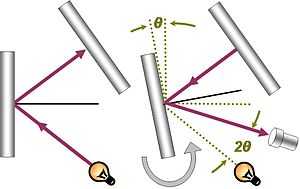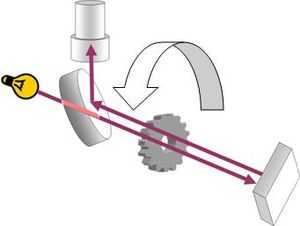Fizeau–Foucault apparatus


The Fizeau–Foucault apparatus (1850) (Figure 1) was designed by the French physicists Hippolyte Fizeau and Léon Foucault for measuring the speed of light. The apparatus involves light reflecting off a rotating mirror, toward a stationary mirror some 20 miles (35 kilometers) away. As the rotating mirror will have moved slightly in the time it takes for the light to bounce off the stationary mirror (and return to the rotating mirror), it will thus be deflected away from the original source, by a small angle.[1] If the distance between mirrors is h, the time between the first and second reflections on the rotating mirror is 2h/c (c = speed of light). If the mirror rotates at a known constant angular rate  , the angle θ is swept in the same time as the light roundtrip, so:
, the angle θ is swept in the same time as the light roundtrip, so:
In other words the speed of light is calculated from the observed angle θ, known angular speed and measured distance h as
The detector is at an angle 2θ from the source direction because the normal to the rotating mirror rotates by θ, decreasing by θ both the angle of incidence of the beam and its angle of reflection.
Foucault based his apparatus on an earlier experiment by Fizeau (Figure 2) who, in 1849, used two fixed mirrors, one partially obscured by a rotating cogwheel.[2] Fizeau's value for light's speed was about 5% too high.
The Fizeau experiment to measure the speed of light in water has been viewed as "driving the last nail in the coffin" of Newton's corpuscle theory of light when it showed that light travels more slowly through water than through air.[3] Newton predicted refraction as a pull of the medium upon the light, implying an increased speed of light in the medium. However, Fizeau showed the speed of light in water to be less than in air, not more, by inserting a tube of water in the light path.[4]
References
- ↑ Ralph Baierlein (2001). Newton to Einstein: the trail of light : an excursion to the wave-particle duality and the special theory of relativity. Cambridge University Press. p. 44; Figure 2.6 and discussion. ISBN 0-521-42323-6.
- ↑ Abdul Al-Azzawi (2006). Photonics: principles and practices. CRC Press. p. 9. ISBN 0-8493-8290-4.
- ↑ David Cassidy, Gerald Holton, James Rutherford (2002). Understanding Physics. Birkhäuser. ISBN 0-387-98756-8.
- ↑ Bruce H Walker (1998). Optical Engineering Fundamentals. SPIE Press. p. 13. ISBN 0-8194-2764-0.
External links
- Diagram showing the original experimental design found in the second volume of Foucalt's collected works: Volume Two - Recueil des travaux scientifiques de Léon Foucault 1878.
- Speed of Light (The Foucault Method)
- Light in moving media

